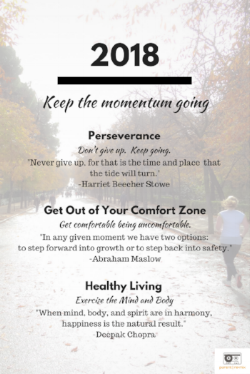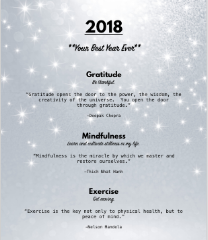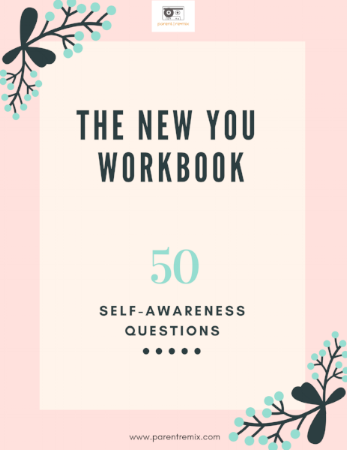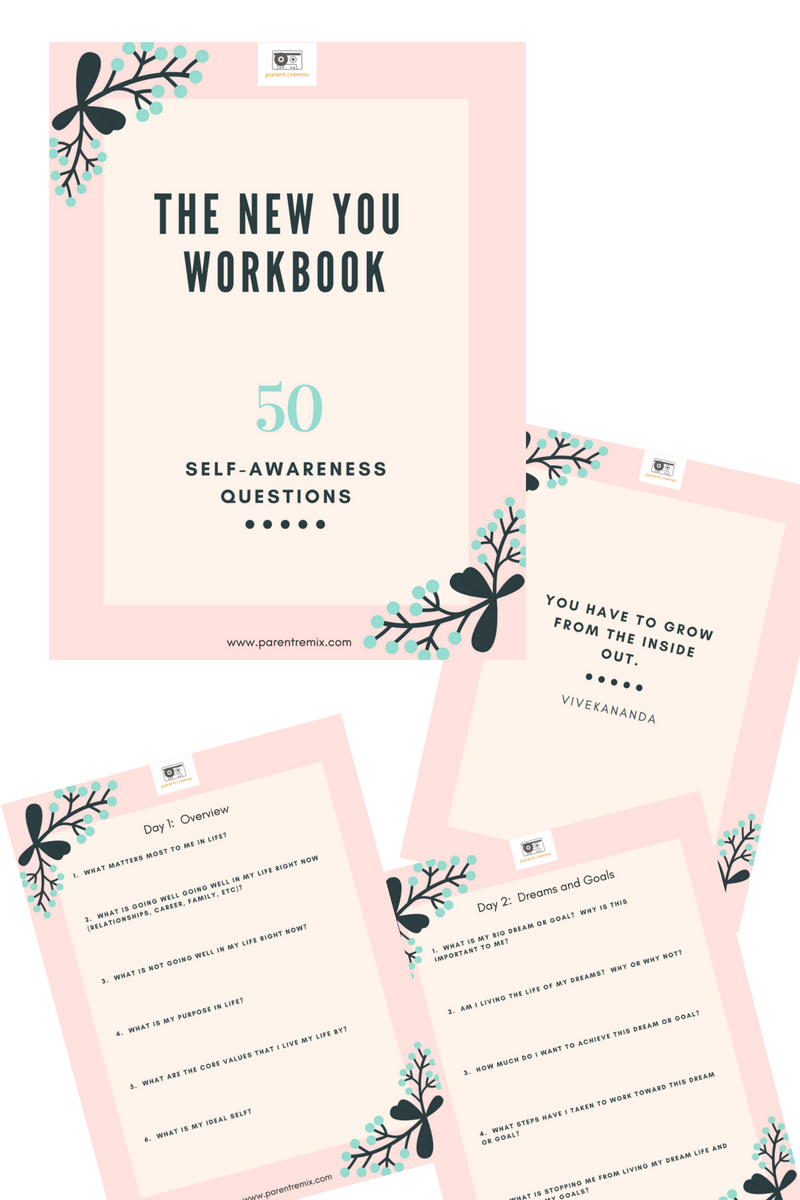Create Your Vision and Set Your Intentions For Your Best Year Ever
/For the past three years, at the end of each calendar year, I’d sit down and reflect upon my vision for the New Year and what I wanted to accomplish and focus on in the upcoming year.
First, I’d brainstorm a “theme” for the year and write down words that reflected values that were important to me. Then, I set my intentions for the New Year by narrowing down the list down to the top three most important ones.
Last year, the three values I chose were:
1. Action
2. Gratitude
3. Perseverance
SET YOUR INTENTIONS AND CREATE A VISUAL REMINDER
I created an 8 1/2” x 11” document highlighting my intentions and focus for the year. Then, I found quotes that I loved and that reflected “why” each value was important to me. I made sure that the document was nice to look at and was easy to read. I kept it posted up on my bulletin board next to my desk, where I looked at it every single day. The document served as a powerful visual reminder of what my focus was on the year.
Interested in creating your own vision document? Let’s deconstruct my 2017 document:
Year: 2017
Overall Theme: “This is the Year”
Focus #1: Gratitude
Tag Line: Be thankful.
Quote: “Gratitude opens the door to the power, the wisdom, the creativity of the universe. You open the door through gratitude.” Deepak Chopra
Focus #2: Action
Tag Line: Just do it.
Quote: “The journey of a thousand miles must begin with a single step.” Lao Tzu
Focus #3: Perseverance
Tag Line: Keep going.
Quote: “It does not matter how slowly you go so long as you do not stop.” Confucius
This year, my overall theme is “keep the momentum going”. You can see and print out a copy of my actual document here. The three areas that I’d like to focus on are:
Focus #1: Perseverance. I carried this one over from last year because I felt it was super important.
Tag Line: Don’t stop. Keep going.
Quote: “Never give up, for that is the time and place that the tide will turn.” Harriet Beecher Stowe
Focus #2: Get Out of Your Comfort Zone. My comfort zone is so, well…comfortable. Which is why it’s a tough one to tackle. But I’m determined to make it a point to get comfortable being uncomfortable this year.
Tag Line: Get comfortable being uncomfortable.
Quote: “In any given moment we have two options: to step forward into growth or to step back into safety.” Abraham Maslow
Focus #3: Healthy Living. I want to focus on my physical and mental health. I’ve done a pretty good job of creating and maintaining a meditation habit the past two years, so I feel like I’m on track with the mental health. However, I’ve allowed myself to be sedentary for many years, and my most recent blood work numbers are reflective of this. My physical health is a top priority for me this year.
Tag Line: Exercise the mind and body.
Quote: “When mind, body, and spirit are in harmony, happiness is the natural result.” Deepak Chopra
CREATE YOUR OWN VISION DOCUMENT FOR THE NEW YEAR
Here’s how you can create your own “vision” document:
1. Download our free template (it looks like the one below). Opt-in to get this template and other freebies in our free resource library here. If you’d rather create your own design, get into Word, Pages, or whatever word processing program you use.
2. If using your own document, choose a pleasing background or color for your document. Type the year in a large font at the top center of the document.
3. Brainstorm your three focus areas to set your intentions for the new year. Some ideas:
Exercise
Healthy Eating
Mindfulness/Meditation
Spirituality
Kindness
Love
Perseverance
Bold Action
Assertiveness
Being a Lifelong Learner
Gratitude
Relationships
Build Confidence
Stress Reduction
Debt Reduction
Volunteerism
Play
Creativity
Journaling
Travel
Empathy
4. After you’ve selected your three focus areas, type them in bold in your document. Include a tagline if you want.
5. Search online for quotes that will help you to focus on your three values. Type into the google search box your query like this: “quotes about creativity”, or “quotes about gratitude”, etc. Once you’ve found quotes that resonate with you, type it below your focus word(s) and tagline.
Print out your vision document and keep it highly visible. I keep one copy on my bulletin board next to my desk, and I shrink a copy to 60% and keep the small copy in my planner.
Use this document to stay focused all year long. I promise it works! It serves as a visual reminder of what’s important to you. This would also be perfect to print and paste on your vision board. If you’d like to learn more about setting goals and creating a concrete action plan for achieving them, read about it here. If you’re starting from square one, become self-aware with 25 questions in this post.
I wish you all your very best year ever! I sincerely hope you create your own vision document for the New Year. If you’d like to share yours, e-mail me…I’d love to see it! If you found this post helpful, please share it with your friends or pin it to your Pinterest boards. Aloha!






















